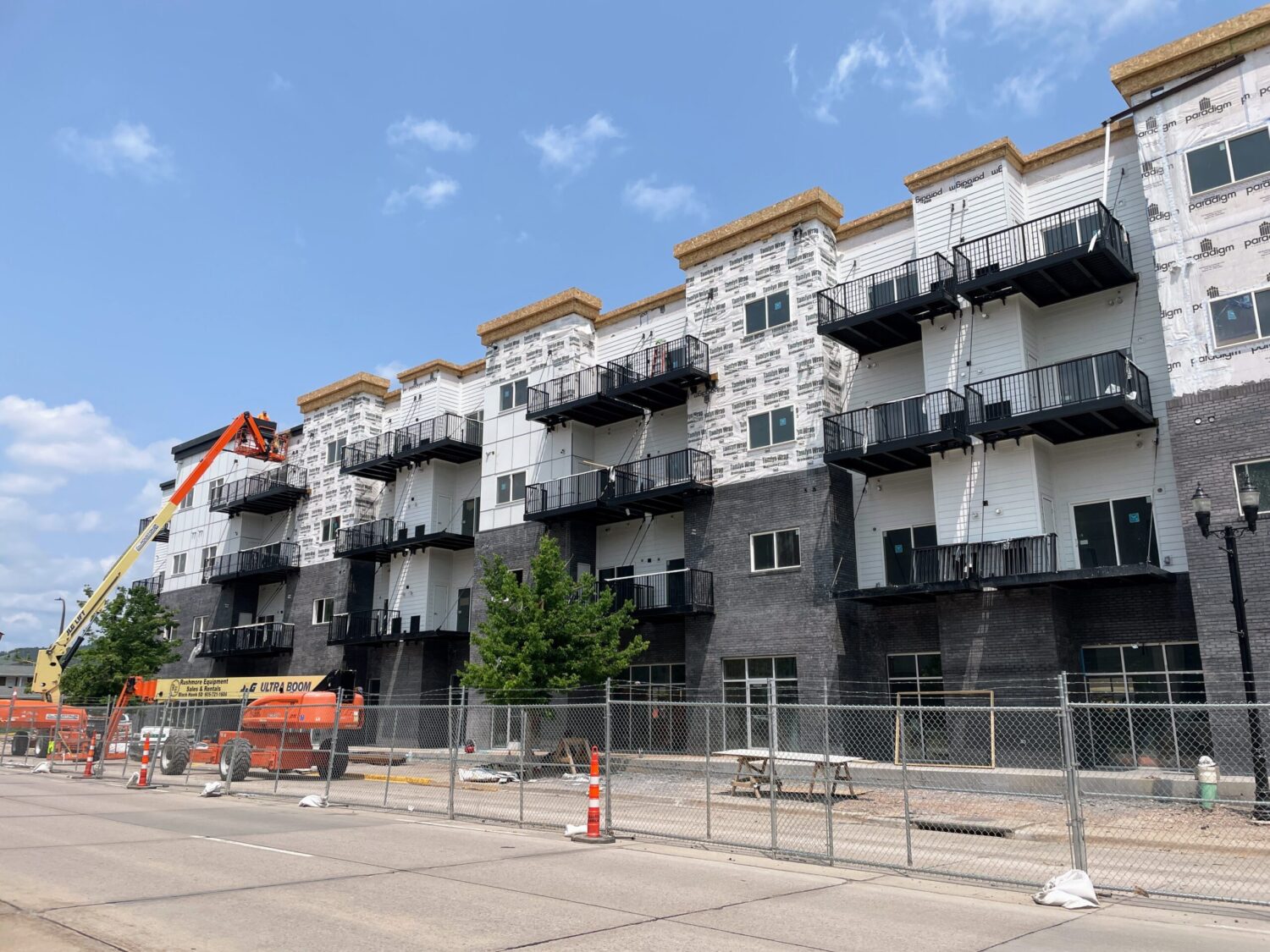 A mixed-use residential and commercial building under construction on June 13, 2023, in downtown Rapid City. (Seth Tupper/South Dakota Searchlight)
A mixed-use residential and commercial building under construction on June 13, 2023, in downtown Rapid City. (Seth Tupper/South Dakota Searchlight)
Tim Henderson/Stateline
More new apartments were built in 2024 than in any other year since 1974 — while South Dakota led the way in approval of new housing units — but the Trump administration’s tariffs and deportations of potential construction workers, plus higher interest rates, could be a wet blanket on the boom.
A U.S. Census Bureau survey found almost 592,000 new apartments were finished last year, the most since the 1970s, when baby boomers sparked a construction surge as they moved out of their childhood homes. There were 693,000 new apartments built in 1974, when the country had about half as many households.
But there has been a steep slowdown in construction starts, as the newly completed apartments come online. The increased supply has lowered rents and increased vacancy rates, making new development less profitable. Some experts also say tariffs on construction materials and labor shortages caused by dips in immigration will create headwinds for new construction.
Apartment starts were down 27% in 2024 compared with 2023, and down 37% from a recent peak of 531,000 in 2022, despite the historic rate of completions. Apartment starts were at their lowest ebb since 2013.
Housing experts have long lamented that there aren’t enough apartments and single-family houses in the U.S. — at least not in places where people want to live and at prices they can afford. Estimates of the national housing shortage last year varied widely, from 1.5 million houses and apartments to 20.1 million; since then, another 1.6 million houses and apartments have been built. Most experts estimate a shortage of 1.5 million to 5.5 million, according to the Joint Center for Housing Studies of Harvard University.
Some states are building apartments faster than others, according to a Stateline analysis. Though completions aren’t tracked by state, permits that lead to new apartments have been granted at high rates in recent years in South Dakota, Utah, Arizona and Colorado. Rates are lowest in Mississippi, Wyoming, West Virginia, Rhode Island, Oklahoma and Alaska.
The massive jump in apartment construction has its roots in 2021 and 2022, when interest rates were low and rent growth was high, said Rob Warnock, senior research associate for Apartment List, a company that posts rental listings online.
“Those new apartments came online in 2023 and 2024, and while those deliveries are slowing down today, there are still many apartments in the pipeline,” said Warnock, who added that “supply and demand are coming back into balance.”
In response to greater supply, rents have fallen by about $50 per month (3.5%) from their 2022 peak, according to a report released this week by Apartment List. Apartment vacancy is at a 15-year high of 6.3%, keeping a lid on rents, but that could turn around as construction slows, according to an April report by Moody’s, a financial services company.
Apartment building has been a bipartisan priority as single-family home prices soar further out of the affordability range for young families. In South Dakota, the Republican-controlled legislature worked to prolong the building boom with grants and loans under the state’s Housing Infrastructure Financing Program. The program put $200 million of state and federal funding toward defraying the costs of development in new neighborhoods, such as roads, sewer lines and streetlights.
Republican state Sen. Casey Crabtree, sponsor of the proposal signed into law in 2023, told Stateline it was needed to address a housing shortage, especially in rural parts of the state.
“We have a drastic shortage of workers,” Crabtree said before a vote in 2023. “South Dakota businesses need more workers in our state. To get more workers, we need more housing.”
Armand Domalewski, co-founder of YIMBY Democrats for America, said overregulation is a barrier to housing construction in many areas that his party controls.
“A lot of blue-government areas and cities have extremely restrictive zoning, impact fees and other rules that make it very difficult to build housing,” said Domalewski. Another barrier is local opposition, he said.
“If it was just a free market, developers would want to build in the places like California, where prices are the highest and rents are the highest, because they’d make more money,” he added.
In California, the 2021 HOME Act was meant to spur more affordable housing and ease labor shortages, but it’s faced local opposition in some areas. At the end of last year, Democratic Gov. Gavin Newsom signed several measures that aim to streamline regulations and crack down on local resistance to the 2021 law.
South Dakota approved nearly 6,000 permits for apartment units in 2023 and 2024, which when completed would add about 1.4% to its 2023 total of 417,000 housing units. That’s the highest rate in the nation. By contrast, Mississippi during that same period approved about 660 apartment units — a fraction of 1 percentage point to its 2023 base of about 1.4 million housing units.
Chas Olson, executive director of the South Dakota Housing Development Authority, said the full impact of the state infrastructure funding isn’t apparent yet, as many developments that received the help are still under construction.
Completions are still strong this year with about 39,000 apartments finished in March, not much different from the 41,500 in March 2024, which was the biggest March number since 1985.
Another impediment to apartment construction has been high interest rates, which make it harder to borrow money to build, said Danushka Nanayakkara-Skillington, an assistant vice president for forecasting and analysis at the National Association of Home Builders.
She expects apartment building starts to slow until later this year.
“We are going to be short of workers for a long time. That’s the way it is. And of course tariffs are going to have an impact,” Nanayakkara-Skillington said.
